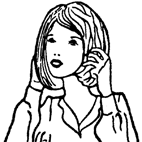Me, reading chapter 3 of Patrick White’s The Vivisector:
It would be too funny if in later chapters he conflates artistic and sexual activity!
Patrick White, chapter 4:
He began fiddling, rubbing, masturbating in nervous paint on a narrow board. […]He put her out of his mind while his drawn-out orgasm lasted: he had already decided to call this painting ‘Electric City’.
Heh heh oh dear.
If I had to recreate the original prank of submitting a chapter of White to a publisher in the expectation of being rejected, and had to use The Vivisector, the first scene between Hurtle and Nance would have suited admirably:
He let down her hair. It fell around them.* […]… Nance was holding the Delicious Monster against her periwinkle of a navel. […]Ahhhh they were flooding together in cataracts of light and darkest deepest velvet.
The whole passage is pretty funny but I can’t be bothered typing the whole thing out. We all know that sex is difficult to write, but White’s attempt to infuse it with a stream-of-consciousness reverie by Hurtle about his childhood only makes things worse.
Nance, by the way, is the Maternal Whore, just in case you thought White had used up all his clichés in the first three chapters. Oh, and later in chapter 4, painting and anal-expulsive behaviour are linked as prosaically as possible. At times it’s like White is simultaneously parodying his novel while writing it.
Perhaps that’s it. Hurtle Duffield’s life as an Australian artist is an imitative parody of life as an artist. The books narrative conceit, and Hurtle’s sense of self, is founded on a sanctimonious, romantic myth of the artist hero, an idea that was in its death throes at the time Hurtle develops into manhood. An impossible idea to convey seriously when the book was written, and one that a “modern” painter like Hurtle can cling to only at the expense of his own relevance to the art he wishes to serve.
The parody turns on Hurtle’s inexplicable, impossible isolation, working like a mad scientist in a B movie; living in a rural shed or suburban Sydney, utterly cut off from any community that would have necessarily, in reality, sustained him. Like an Australian in the world, Hurtle works disconnected from his social context: White explains that Hurtle actively avoids contact with fellow artists. His study in Paris is barely mentioned and seems to have made no impact upon him.
Before the Great War Wyndham Lewis was already publishing manifestos in London, rejecting the judgement and classification of art upon psychic criteria, renouncing the possibility of discerning psychology through paint. Lewis wrote several novels set amongst the artistic community in London. In each of these he depicts artists not as sensitive individuals, but as a pack, a caste, enacting a grotesque, vicious parody of the society from which they disdainfully set themselves apart, needing to exploit each other as much as the greater community at large. The Revenge for Love (1937) focuses on an expatriate Australian painter, whose daily life at home and grappling with his chosen medium are reflected in White’s descriptions of Hurtle painting at home. There is also a strange, siginificant event in the plot common to both works, which I won’t describe for fear of dropping spoilers to either book.
Perhaps I’m too enamoured of Lewis at White’s expense, but White’s most perceptive writing in The Vivisector has come when its world comes closest to Lewis’, in his study of the relationship between Hurtle and Caldicott, his dealer: the two of them cagily playing up to their roles, seeking simultaneously to cajole and dismay.
Incidentally, unlike Hurtle Duffield, Lewis’ Victor Stamp holds no delusions about his own importance, or indeed his own worth as a painter. Realising he will never be any good, what passion he had has dissipated, and he paints in a perpetual state of hapless bemusement.
There was, however, a consolation for these things. But it was a consolation with which he passionately refused to have anything to do. It was this. Most Australian or English artists were little, if any, better than he was himself.
* “Waaah, I’m bald!” she cried. (Sorry – blame The Muppets.)

I'm starting to think that Hurtle makes more sense as a self-portrait of White, translated into another medium, than as a depiction of an actual artist. His social isolation seems more appropriate to a writer than a painter. The guy's never made a single life-study.
Thanks for pointing up the parallels to Lewis. I'm a fan of his criticism but have never made it through one of his novels (have tried The Apes of God and The Childermass). Will have to give The Revenge for Love a go now.
Now I keep imagining how Lewis might have reviewed The Vivisector – it would have been a savagely enjoyable hatchet-job, I think.
You could be right about Hurtle being a substitute writer. His character does seem odd, given that White knew enough painters.
In his nastier moments White gets pretty close in attitude and style to some of Lewis' writing. (Which would doubtless provoke Lewis all the more had he read it.) The Revenge for Love is probably the most accessible of his novels, and one of his strongest. Although Apes of God is episodic enough to pick up again any time.